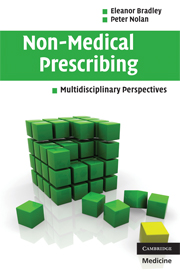Book contents
- Frontmatter
- Contents
- List of contributors
- Foreword
- Preface
- Acknowledgements
- Introduction
- 1 Medicines and prescribing – past and present
- 2 Nurse prescribing – impact, education and sustainability
- 3 Nurse prescribers: from 2003 to 2006
- 4 Nurse prescribing experienced
- 5 Nurse prescribing observed
- 6 Pharmacists and prescribing
- 7 Professions allied to medicine and prescribing
- 8 Conclusions
- Index
- References
2 - Nurse prescribing – impact, education and sustainability
Published online by Cambridge University Press: 22 August 2009
- Frontmatter
- Contents
- List of contributors
- Foreword
- Preface
- Acknowledgements
- Introduction
- 1 Medicines and prescribing – past and present
- 2 Nurse prescribing – impact, education and sustainability
- 3 Nurse prescribers: from 2003 to 2006
- 4 Nurse prescribing experienced
- 5 Nurse prescribing observed
- 6 Pharmacists and prescribing
- 7 Professions allied to medicine and prescribing
- 8 Conclusions
- Index
- References
Summary
Introduction
This chapter is based on my involvement with nurse prescribing – the observations I have made and the impressions I have formed. I became involved with nurse prescribing when I was first appointed as a lecturer and tasked with setting up a prescribing course for almost a thousand district nurses and health visitors in Shropshire and Staffordshire. This was a daunting prospect; however, I firmly believed that extending prescribing to nurses and health visitors would improve health care for a large number of people. My enthusiasm for the job was heightened by the fact that the government was eager to train as many non-medical prescribers as possible. The course content was largely determined by the English National Board for Nursing, Midwifery and Health Visiting, the predecessor of the Nursing and Midwifery Council (NMC). The mode of delivery, the teaching and learning methods and the personnel involved were left to the discretion of course leaders and individual organisations. Internal university approval and ENB approval was required to validate the course.
I talked to the first group of students about their expectations, what they hoped to achieve, their educational needs and how they were intending to integrate prescribing into their current roles. My vivid recollection of these nurses was their disenchantment with how few items they were able to prescribe from the Community Practitioner Formulary (CPF) and the fact that they had little choice about undertaking the prescribing role.
- Type
- Chapter
- Information
- Non-Medical PrescribingMultidisciplinary Perspectives, pp. 35 - 50Publisher: Cambridge University PressPrint publication year: 2008



